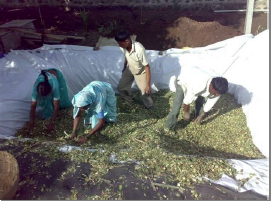Green fodder can be preserved as silage stored for long period (upto 6months). During the monsoon, plenty of green grass is available. Most commonly, it is cut as dry grass and stored for feeding livestock in summer. If it is cut at the early flowering stage can be preserved as silage, then the grass will be more nutritious.
The ensiling process involves many steps which should be timed and controlled carefully, in order to ensure successful ensiling with minimal losses. Silage may be defined as the green succulent roughage preserved under controlled anaerobic fermentation in the absence of oxygen by compacting green chops in air and water tight receptacles.
In the ensiling process, the absence of oxygen, leads to the fermentation of water soluble carbohydrates to produce organic acids which increase acidity of the material (pH about 4.0). Such anaerobic acid production (mainly lactic acid) arrests the growth of bacteria and moulds as well as inactivates putrefying organisms, i.e. acts as a preservative. Consequently, the process reduces nutrient losses and change in nutritive value. It serves as one of the best method of fodder conservation. Unlike hay making, which has seasonal constraints and heavy nutrient losses, silage on the other hand is superior and has better acceptability, digestibility and nutritive value. |

